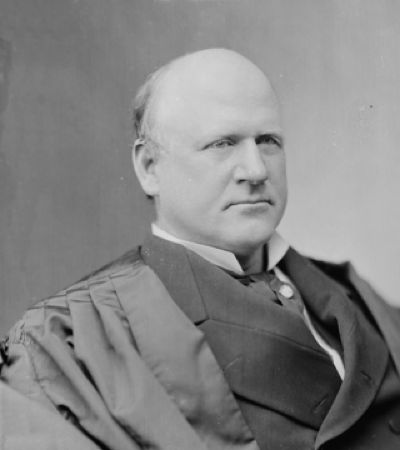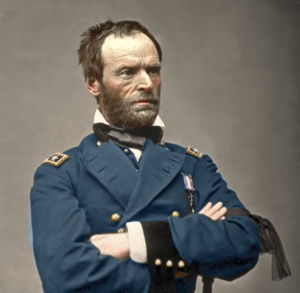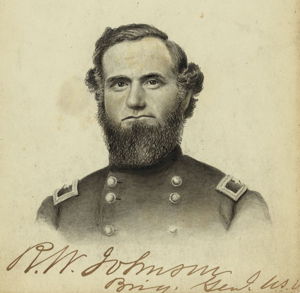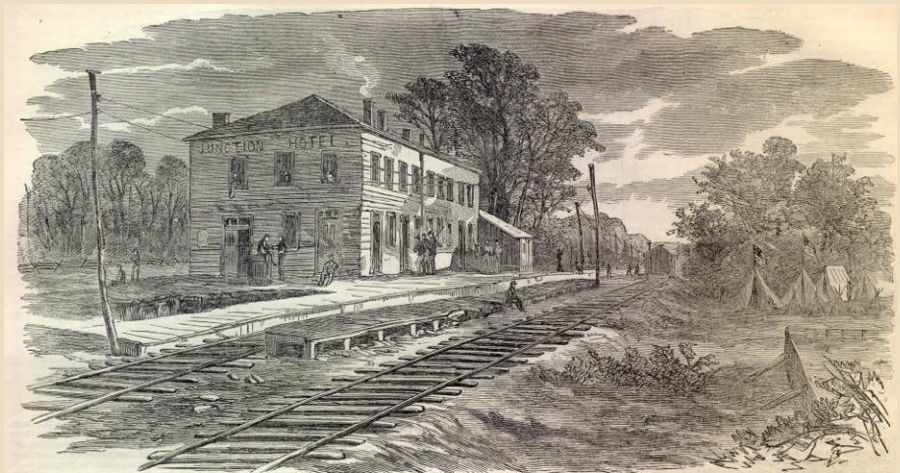
The following article by Charles Hartley originally appeared in The Courier-Journal on 10 Oct 2012. It is archived here with additional information for your reading enjoyment.

John Marshall Harlan, a Kentucky native best remembered for his service on the United States Supreme Court, was twice instrumental in the defense of Lebanon Junction during the early part of the Civil War.
The first instance took place in September 1861. General William T. Sherman had arrived in Louisville on the 16th, just in time to hear a report that the railroad bridge at Lebanon Junction had been burned. It was also believed that Confederate General Simon B. Buckner was leading a force that intended to march on Louisville.
James Guthrie, then president of the Louisville & Nashville Railroad, told Sherman that just beyond Lebanon Junction were several high and important trestles which, if destroyed, would take months to replace. Sherman also learned that Muldraugh's Hill was a strong position that must not fall into the enemy's hands.
However, Sherman was, at that time, a general without an army. All that was available to him was General Lovell Rousseau's Louisville Legion, then camped across the Ohio River in Indiana, and a small number of Home Guards in Louisville. These were quickly gathered, and by midnight were aboard trains heading for Lebanon Junction.


Among the Home Guards was a unit named the Crittenden Union Zouaves under the command of then Captain Harlan. This company constituted the guard at General Sherman's headquarters, which was established in the hotel at Lebanon Junction.
Finding the wooden bridge burned, Sherman had the majority of his forces ford the stream and moved on to Muldraugh's Hill, leaving Brigadier General Richard W. Johnson in charge at Lebanon Junction with only Captain Harlan's company in place. Then Sherman sent a message back, indicating that he expected a fight, and ordered Johnson to send him five thousand rounds of ammunition.
Johnson gave this task to Captain Harlan who had to solve the problem of getting that ammunition across the river with the bridge down. According to Johnson's memoirs, Harlan "went back that night some two miles along the railroad and aroused a farmer, and told him to hitch up his wagon and prepare for a movement into the enemy's country. The farmer demurred, but, seeing that resistance was useless, he got up and harnessed his team. Then he was required to drive to the Junction, where there was a hand-car. This hand-car was placed on top and across the wagon body, and around it were placed the boxes of ammunition. About this time it was broad daylight, and Harlan started with the team for the crossing of the Rolling Fork. The stream was 'belly deep' to the horses, but was safely crossed. In order to direct the team, Harlan mounted the leader without a saddle. On reaching the south bank the hand-car was placed on the railroad track, the ammunition loaded on it, and then pushed to the top of the hill, and down grade to Sherman's headquarters."
Not long after this, on 27 Sep 1861, Harlan announced his intention to raise a regiment for the Union cause. Within a month the regiment was at capacity with Harlan as its colonel. It was designated as the Tenth Kentucky Infantry, and saw frequent action over the next year.
On Christmas evening 1862, Harlan's regiment was at Gallatin, Tennessee when he was ordered northward in pursuit of John Hunt Morgan's raiders. When he reached Bowling Green, he learned that Morgan was likely north of Munfordville, and that the railroad bridges and trestles in that area were in danger of being destroyed. This included the reconstructed bridge over the Rolling Fork River at Lebanon Junction.
After disembarking at Munfordville, Harlan moved his forces to Elizabethtown where he learned that Morgan was encamped on the Rolling Fork, where the Elizabethtown and Bardstown road crosses that stream. Sending his cavalry in advance, Harlan marched his infantry in that direction. Reaching the ridge above Morgan's encampment, the Union forces engaged the enemy with cannon and rifle fire which was returned. While this skirmish was taking place, two of Morgan's regiments and a portion of his artillery which had marched toward Lebanon Junction to destroy the bridge there, upon hearing the sounds of rifle and artillery fire, abandoned their task and returned to assist their brothers in arms.
After the rebels broke off the engagement, Harlan moved his troops to defend the bridge at Lebanon Junction and remained there until he was ordered back to Gallatin. He filed a report of his command's actions in which he stated, "I claim, for my command, that it saved the Rolling Fork Bridge, and most probably prevented any attempt to destroy the bridge at Shepherdsville, thus saving from destruction property of immense value, and preventing the utter destruction of the line of railway, by which our army, near Nashville, was mainly supplied."
Harlan served for another year, until the death of his father in February 1863, whereupon he resigned his commission and returned to Frankfort to support his family, and resume his law career. Soon after he was elected as Attorney General of Kentucky. He joined the Republican Party in 1868, and unsuccessfully ran for Kentucky Governor twice. Then, after his support for Hayes in the 1876 presidential election, Hayes nominated him to the United States Supreme Court the following year. He served on the court until his death in 1911, a man respected for his work on the bench, and now you know him as a leader of men as well.

Copyright 2012 by Charles Hartley, Shepherdsville KY. All rights are reserved. No part of the content of this page may be included in any format in any place without the written permission of the copyright holder.
The Bullitt County History Museum, a service of the Bullitt County Genealogical Society, is located in the county courthouse at 300 South Buckman Street (Highway 61) in Shepherdsville, Kentucky. The museum, along with its research room, is open 10 a.m. to 4 p.m. Monday through Friday. Saturday appointments are available by calling 502-921-0161 during our regular weekday hours. Admission is free. The museum, as part of the Bullitt County Genealogical Society, is a 501(c)3 tax exempt organization and is classified as a 509(a)2 public charity. Contributions and bequests are deductible under section 2055, 2106, or 2522 of the Internal Revenue Code. Page last modified: 12 Sep 2024 . Page URL: bullittcountyhistory.org/memories/harlan.html